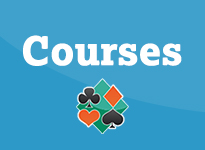
Book a Course
View all the latest courses going on at the bridge club and book yours now...Answers:
Answer #50
Three possible hands are given for South but only one is consistent with bidding. Which one? What should the other hands have bid? Neither side is vulnerable
| North | East | South | West | |||
| 1 ♠ | Pass | 1NT |
| Hand a) |
|
♠ -- ♥ K 9 7 4 3 2 ♦ Q 9 7 3 2 ♣ 8 6 |
| Hand b) |
|
♠ Q 4 ♥ K J 10 7 ♦ A 10 8 2 ♣ 10 9 4 |
| Hand c) |
|
♠ Q 9 2 ♥ 8 2 ♦ A 5 3 2 ♣ J 9 4 2 |
Answer:
a) is correct.
a) is correct.
- Hand (a) only contains five points but tabling your hand as dummy to 1♠ is surely a poor idea. Yet so is responding 2♥, failing the Rule of 14 (points in hand plus no. of cards in the longest suit does not get to 14) because 2♥ is 100% forcing and you may well go overboard. Best is to scrape up the dustbin 1NT, borrowing a point. Who knows, partner may be about to rebid 2♦ or (better still) 2♥. If partner rebids 2♣, you’ll bid 2♥, which normally shows six cards. If partner rebids 2♠ (or, worse, 3♠), you beat a hasty exit (from the room as well as from the bidding). But it’s worth the risk.
- With Hand (b), you are too strong for the 6-9 point 1NT and should respond 2♦, the cheaper of fours.
- With Hand (c), you should prefer to raise to 2♠ with three-to-an-honour than bid the last resort dustbin 1NT.





